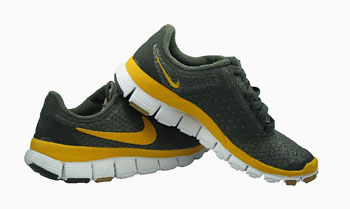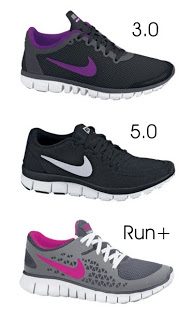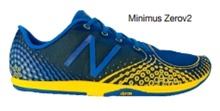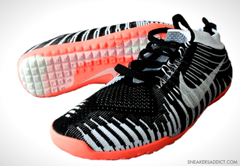In my previous post (On Minimalist Running Shoes: Vibram has Balls, Nike Dropped Them), I expressed my disappointment with Nike for the direction they appear to be heading with their Free line of “barefoot-simulating” running shoes. In particular, I feel that marketing of the new Nike Free Run+ as a “barefoot-like” shoe is disingenuous, particularly given the top-notch science that has come in on barefoot running in the past few years (e.g., Daniel Lieberman’s recent study in Nature). A shoe with a heel as thick as that found on the Free Run+ (see below) will do very little to promote the midfoot/forefoot strike that characterizes barefoot running.
Well, reviews of the Free Run+ are starting to come in, and the first one that I’ve found comes from none other that Wired on-line by Steven Leckart. Wired prides themselves on being on the cutting edge of topics relating to science and technology, and it is for this reason that I found their review of the Nike Free Run+ disappointing. Not only does it fail to correctly apply the science that has come out, it ignores good information that they themselves put out last year associated with their review of the Vibram Fivefingers.
All it takes is a reading of the first line of the Wired review to realize where it’s heading: “Running barefoot may reduce your risk of injury, some say.” Yes, some may say this, but lets be clear here: there is no definitive body of literature showing that running barefoot, or in shoes for that matter, reduces the risk of injury.
The second sentence isn’t much better: “But jogging in freaky rubber socks like the Vibram FiveFingers? Those just boost the chances of strangers heckling you as you prance by.” Yes, I agree they look strange, and many think they’re ugly, but the Fivefingers do barefoot-like running as good or better than any other shoe out there on the market. If you want to run as close to barefoot as possible, you can’t do better than the Vibram Fivefingers (or maybe something like a pair of Huaraches). And ask yourself why they look ugly? It’s because they, god forbid, actually match the anatomical shape of the human foot! We wouldn’t want that in a barefoot-like running shoe, would we?
Wired then goes on to describe the new Free Run+ as “significantly cooler-looking sneakers that simulate barefoot conditions.” Well, Nike is good at making cool-looking sneakers, I’ll give them that, and if that’s what you’re after, then by all means go buy a pair of these. If “barefoot-like” is what you want, then these are not your best choice.
Next comes a line that I agree with: “The company’s earlier models provide even less support (thus are even better at simulating barefoot experience), but unless you’re already an experienced barefoot runner, the Free Run+ is a good place to start.” I’m a huge fan of the Free 3.0 – it still has a heel, but it appears to be much smaller than the one on the Free Run+, and it offers very minimal support in the upper (see comparison image below and to the left). The Free Run+ is sure to be more flexible and lightweight than most running shoes, and in that sense it would be a good place to enter into a more minimalist style of shoe.
Ignoring the comment about shinsplints, which typically are a problem for newer runners, the statement in this review that really raised my ire was the following: “Perhaps wearing a “barefoot shoe” is, in and of itself, a constant reminder to reduce the heel-stomping. After all, you can’t slam your heel down hard without a big wedge of rubber under it, so shoes like the Nike Frees force you more onto your midfoot and toes.” I don’t know how you can possibly look at the heel on the Free Run+ and make this statement – it looks to me to be even bigger than that found on both the Free 3.0 and the Free 5.0 (see image to the left – Update: apparently I’m incorrect about the heel, see this post for more). In their introduction of this shoe, Nike even touts the improved cushioning of the Free Run+. Barefoot-like running is about minimizing cushioning and the size of the heel, and this shoe, therefore, is even further from “barefoot-like” than previous models in the Free line.
I’ll finish by pointing out the the image that Wired includes with their review appears to be a different shoe than the Free Run+ I’ve seen in all of the photos on-line (compare the shape of the heel and the width of the yellow band above the sole in the image at the top of this post to the Free Run+ shown in the image in my comparison picture). To be honest, the picture included in the Wired article actually looks to have the biggest heel of any shoe pictured in this post (Update – thanks again to Dennis in the comments for pointing out that this is a photo of the Free 5.0 v4, not the Free Run+. Not sure why, but the heel looks unnaturally large in that photo. Even more unsure as to why there’s a picture of the Free 5.0 in a review of the Free Run+???)! [Update 5/15/2010: Glad to see they finally changed the image to the correct shoe!]
What’s most disappointing to me is that Wired themselves put out a video last year showing the difference in footstrike that occurs when wearing the Vibram Fivefingers vs. a more typical shoe (see below). Maybe they should do a similar comparison involving the Free Run+ – I’d be willing to bet that the Vibrams promote a more barefoot-like footstrike.
So, I’ll agree with Wired that these shoes might work as a entry-level minimalist shoe in terms of their light weight and flexibility, but they’re far from being the “barefoot-like” shoe that Nike is marketing them as. From a news outlet like Wired who values accurate reporting on science and technology, I would’ve expected better in this review, particularly in light of their excellent previous work on the Vibram Fivefingers.
Update 10/27/2010: I have now posted my own Nike Free Run+ review. Check it out here: https://runblogger.com/2010/10/nike-free-run-review-nice-transitional.html.





















Hello Dr. Larson! Big fan of the website and am an active MS candidate looking at some metabolic indices using minimalist footwear as intervention. I came here looking for your list of articles but cannot see them — is there another place to find them?
What articles are you looking for?
—-
Pete Larson’s Web Links:
My book: Tread Lightly – link to ow.ly
Blog: https://runblogger.com
Twitter: link to twitter.com
Facebook: link to facebook.com…
Any that consider metabolic costs especially the University of Colorado (2010?) study. Thank you for the consideration.
Here’s a link to my article about the Colorado study: link to runblogger.com…
—-
Pete Larson’s Web Links:
My book: Tread Lightly – link to ow.ly
Blog: https://runblogger.com
Twitter: link to twitter.com
Facebook: link to facebook.com…